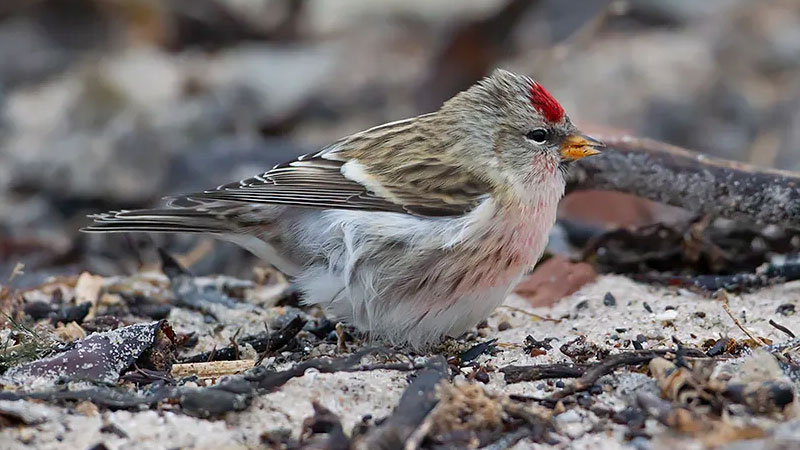Redpoll
Acanthis flammea (Linnaeus 1758)
Photo: © Mathias Putze

“Common” Redpoll
Appearance
Brown and white birds with heavily streaked sides. Small red forehead patch, black feathering around a yellow bill, and two white wingbars. Males have a pale red vest on the chest and upper flanks. Variation is great across the subspecies.
Size: L 5.25″
Shape: Small, deep-bellied, small-headed, broad-necked bird with a relatively thin- based, sharply pointed conical bill and moderate-length strongly notched tail. Dis- tinguished from very similar Hoary Redpoll (with caution and adding plumage clues) by slightly longer and proportionally narrower-based bill, creating a more acute point; slightly more sloping forehead; and rounded crown (when crest is relaxed).
Adult: Both Common and Hoary Redpolls have red forecrown, black chin and lore,
2 white wingbars. Key clues to distinguishing the species (besides shape) are undertail coverts, rump, flank streaking, wingbar width, and color of scapular edges. Common Redpoll has white undertail coverts with 2 to many broad dark streaks; a dusky or whitish rump with extensive dark streaking (except older male, which can have bright pinkish-red rump); extensive broad dark streaking on the flanks; moder- ately wide white tips to greater secondary coverts; and brownish edges to scapu- lars, creating a dark-brown back.
Adult Male: Pinkish-red to bright red on breast and flanks, feathers tipped with white when fresh and wearing away over the year, revealing deep red.
Adult Female: Little or no pink on breast and flanks; generally darker than male on back. Similar female Hoary Redpoll paler overall; whitish undertail coverts with
0–3 thin dark streaks; whitish rump with little or no streaking; a few thin dark streaks on flanks; broad white tips to greater secondary coverts; grayish edges to scapulars, creating a frosty look to back; adult male with wash of pink on breast and flanks; adult female with essentially no pink.
1st Year: Often shows molt limits, with inner greater coverts fresher, darker, and more broadly tipped with white than older outer coverts. M. usually with wash of pink on breast and flanks; f. with no pink.
Juv: (July–Aug.) Generally streaked brown overall without red or black on head; buffy wingbars.
Natural History
Regularly found in the boreal and taiga regions of Canada occasionally southward into northern half of the United States in irruption years.
“Common/Mealy Redpolls” in Europe are regularly found in Fenno Scandia regularly southward into Central Europe in irruption years.
Taxonomy
“Common/Mealy” Redpoll Acanthis flammea flammea
-> N Europe, Siberia, Alaska and Canada
Common/Mealy Redpoll Acanthis flammea rostrata (incl. ssp. islandica)
-> NE Canada, Greenland, Iceland
Object of study
Vocalizations and plumage variability. Please send photos if you have a redpoll you’re not sure of what species it is. We hope to help people with ID’s of Hoary Redpolls.
Flight Call
A clipped and dry che or chit, given singly or more usually as 2 or 3 calls, or even longer series of chee-chee-chee or chit-chit-chit. Resembles chyet-chyet or chet-chet of White-winged Crossbill, but is dryer and softer as if coming from a smaller bird. Some calls similar to Pine Siskin but without the raspy or throaty quality.
Food Sources
Likes to eat small seeds of trees and shrubs, especially birch, willow, alder, spruce, and various grasses, sedges and weed seeds. It will visit nyjer or sunflower seed feeders of all shapes and forms including nyjer seed socks.
Irruptions
For many years it irrupted in numbers biennially southward to the Mid-Atlantic and Midwestern States, but irruptions have been less common the past decade; also irrupts with less frequency into Pacific and Mountain West States.
“Hoary” Redpoll
Appearance
Frosty birds with frosty white backs. Small red forehead patch, black feathering around a yellow bill, and two white wingbars. Reduced streaking on flanks and undertail coverts. Males have a pale pink vest on the chest. Variation is great across the subspecies.
Natural History
Are regularly found in the boreal and taiga regions at the very northern edge of where Common/Mealy Redpolls are found in Canada; occasionally is found southward into northern half of the United States in irruption years.
Hoary/Arctic Redpolls in Europe are regularly found in N Europe and on Greenland; occasionally found southward into Central Europe in irruption years.
Taxonomy
Hoary/Arctic Redpoll Acanthis hornemanni exilipes
-> N Europe, Alaska and NW Canada
Hoary/Arctic Redpoll Acanthis hornemanni hornemanni
-> NE Canada and Greenland
Object of study
Plumage characteristics and vocalizations in relation to taxonomy.
Flight Call
A clipped and dry che or chit, given singly or more usually as 2 or 3 calls, or even longer series of chee-chee-chee or chit-chit-chit. Resembles chyet-chyet or chet-chet of White-winged Crossbill, but is dryer and softer as if coming from a smaller bird. Some calls similar to Pine Siskin but without the raspy or throaty quality.https://macaulaylibrary.org/asset/233165/embed/640
Food Sources
Likes to eat small seeds of trees and shrubs, especially birch, willow, alder, spruce, and various grasses, sedges and weed seeds. It will visit nyjer or sunflower seed feeders of all shapes and forms including nyjer seed socks.
Irruptions
Irrupts in very small numbers in years that Common Redpolls irrupt in large numbers.
For more on Hoary/Artic Redpolls see here:
ARTICLE
For more on Common/Mealy Redpolls see here:
ARTICLE
“Lesser” Redpoll
Appearance
Brown and white birds with heavily streaked sides. Small red forehead patch, black feathering around a yellow bill, and two white wingbars. Males have a pale red vest on the chest and upper flanks.
Natural History
Lesser Redpolls are regularly found on the British Islands, Southern Fenno Scandia, northern Central and Eastern Europe.
Taxonomy
monotypic (species status controversial)
-> Britain to C Europe
Object of study
Vocalizations in relation to taxonomy.
Flight Call
A clipped and dry che or chit, given singly or more usually as 2 or 3 calls, or even longer series of chee-chee-chee or chit-chit-chit. Resembles Two-barred and Type D Red Crossbill flight calls, but usually smaller gaps between phrases.
Irruptions —
For more on Lesser Redpolls see here:
PAPER



